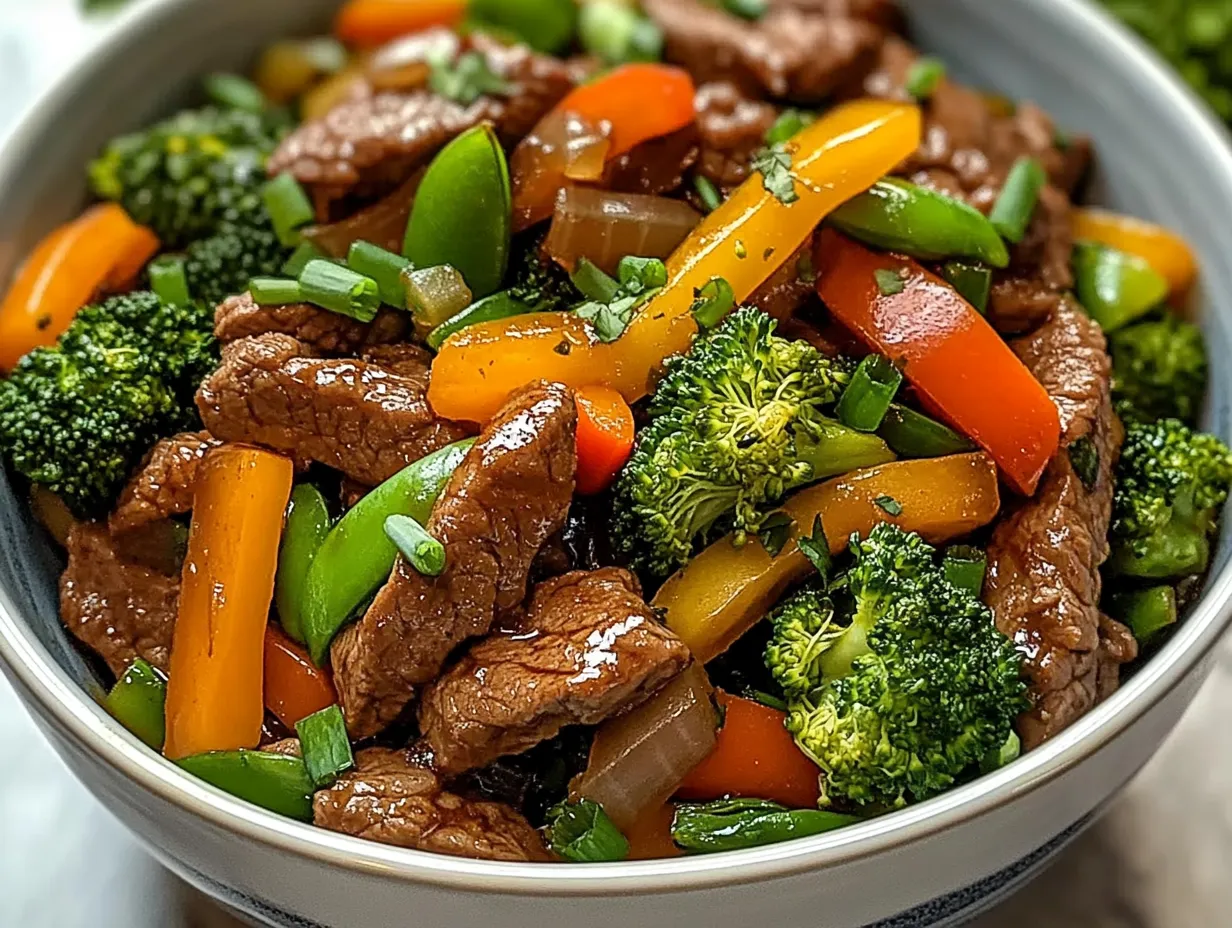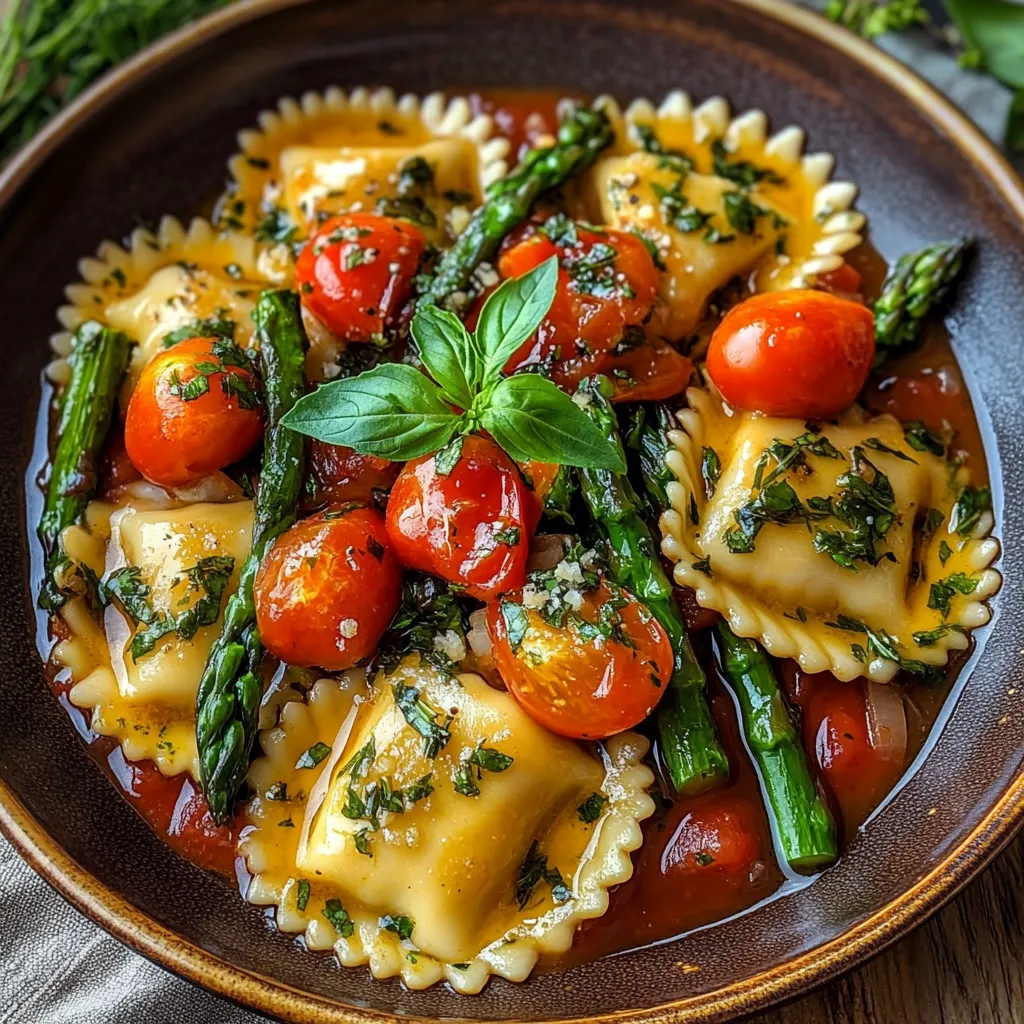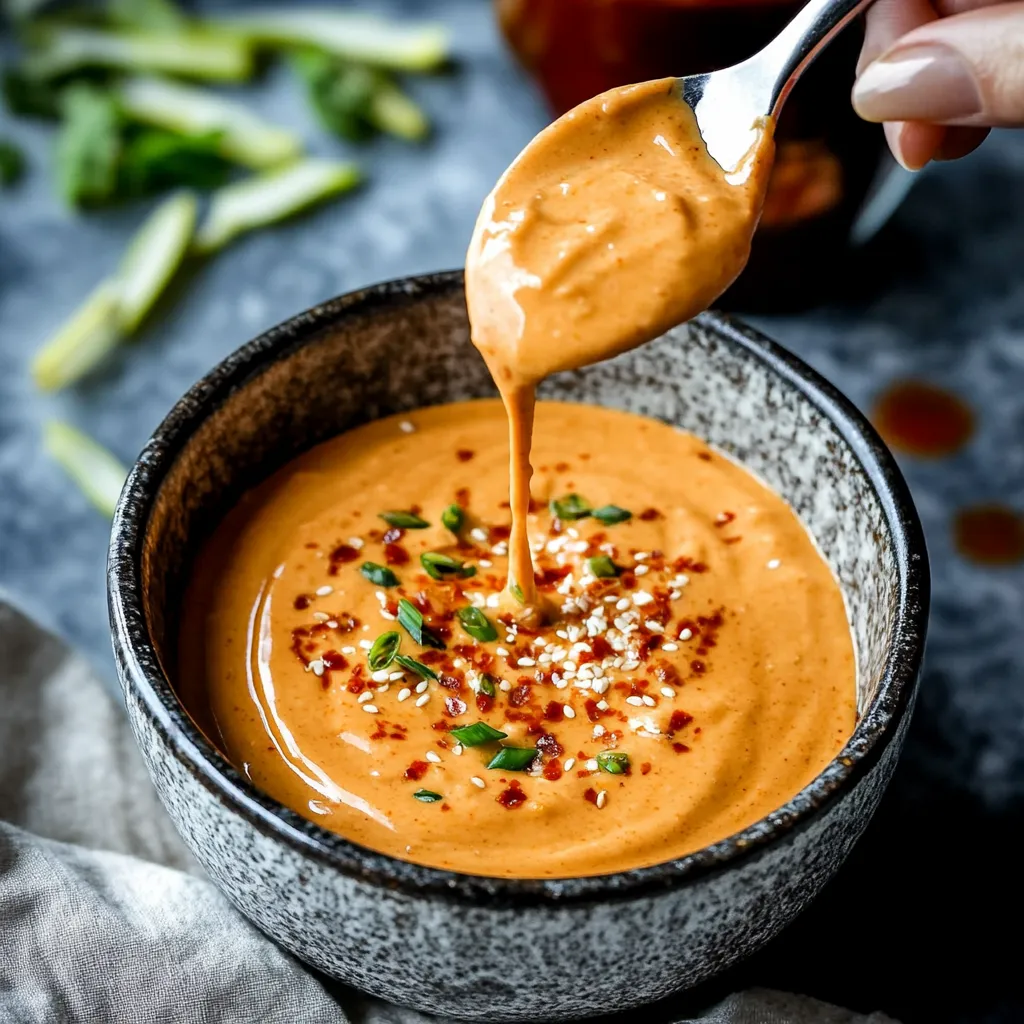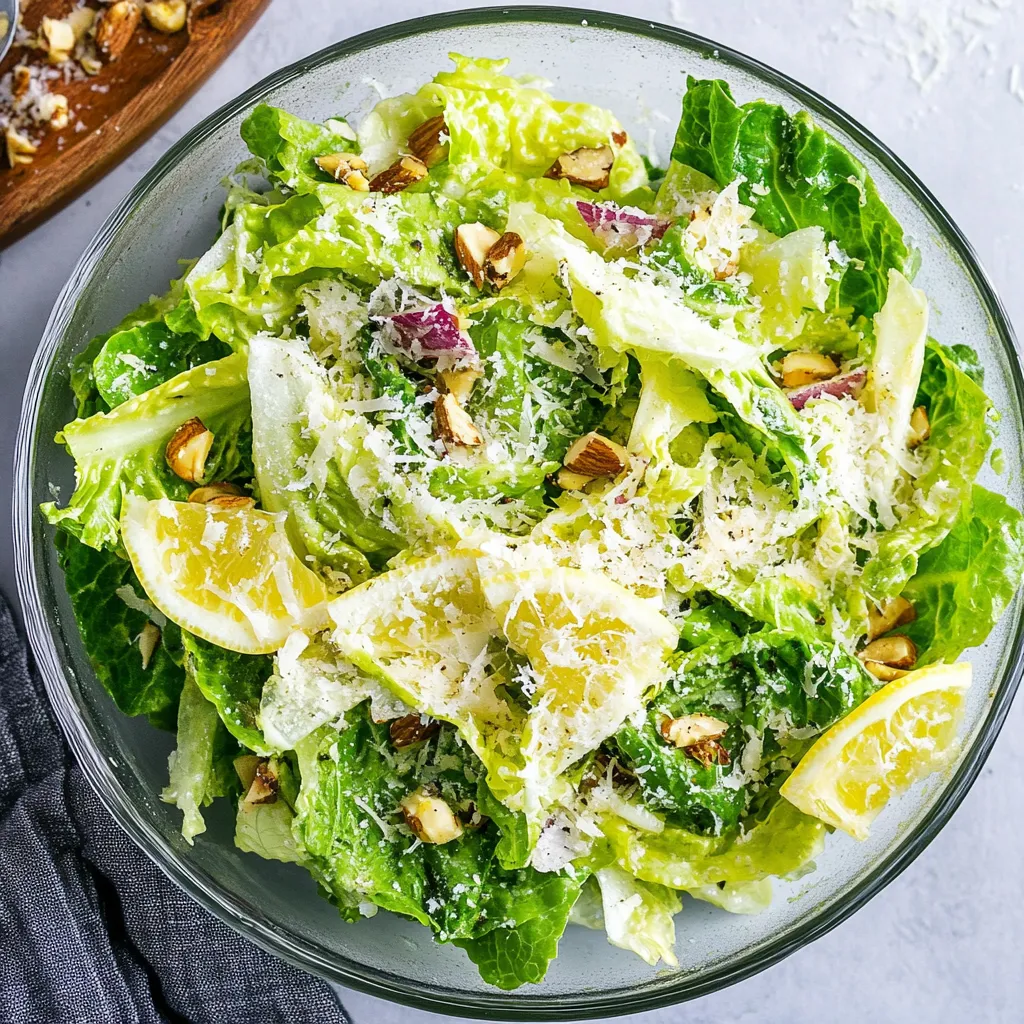Introduction
Discover the ultimate beef stir fry with vegetables that combines tender strips of beef with colorful, crisp vegetables in a savory sauce that will tantalize your taste buds. This quick and easy 30-minute meal is perfect for busy weeknights when you need a nutritious dinner on the table fast. Whether you’re a seasoned chef or a cooking novice, this beef stir fry recipe delivers restaurant-quality flavor with minimal effort. The beauty of this homemade beef stir fry with vegetables is its versatility – customize it with your favorite vegetables, adjust the sauce to your taste preferences, and serve it over rice or noodles for a complete meal that the whole family will love.
The origins of stir frying date back centuries in Chinese cooking, where this quick cooking method developed as a way to prepare meals efficiently while conserving fuel. Today, beef stir fry with vegetables has become a beloved global dish, appreciated for its perfect balance of protein, vegetables, and bold flavors. Our 30-minute version stays true to the traditional technique while making it accessible for home cooks seeking quick, healthy dinner solutions. This recipe has been tested and perfected to ensure that your beef stir fry with vegetables turns out tender, flavorful, and perfectly cooked every single time.
Why You’ll Love This Beef Stir Fry
- Ready in just 30 minutes – perfect for busy weeknights when time is limited!
- Packed with protein and vegetables – a complete, nutritious beef stir fry with vegetables meal in one pan
- Incredibly versatile – easily customize your beef stir fry with vegetables recipe with your favorite vegetables and protein cuts
- Budget-friendly – use affordable beef cuts that become tender with quick cooking
- Meal-prep friendly – components can be prepared ahead of time for quick assembly
- Kid-approved – the savory sauce makes vegetables more appealing to picky eaters
- Restaurant-quality flavor at a fraction of the takeout cost
- Perfectly balanced flavors – sweet, savory, and umami in every bite of this delicious beef stir fry with vegetables
According to a survey by Statista, stir-fry dishes rank among America’s top 10 favorite weeknight meals, and it’s easy to see why! For more inspiration on quick dinner recipes, check out our site’s 30-Minute Meal Collection featuring dozens of fast and flavorful options for busy families.
Ingredients for Beef Stir Fry
For the Beef and Marinade:
- 1 pound beef sirloin or flank steak, thinly sliced against the grain
- 1 tablespoon cornstarch
- 1 tablespoon vegetable oil
- 1 tablespoon water
- ¼ teaspoon baking soda (optional, for extra tenderness)
For the Vegetables:
- 1 bell pepper (red or multi-colored), sliced
- 1 cup broccoli florets
- 1 carrot, julienned
- 1 cup snap peas or snow peas
- 8 oz mushrooms, sliced (optional)
- 2-3 green onions, chopped
For the Stir Fry Sauce:
- ¼ cup low-sodium soy sauce
- 2 tablespoons hoisin sauce
- 1 tablespoon sesame oil
- 1 tablespoon honey or brown sugar
- 2 cloves garlic, minced
- 1 tablespoon fresh ginger, grated
- ¼ cup water or beef broth
- 1 tablespoon cornstarch (to thicken)
For Garnish:
- Sesame seeds
- Additional chopped green onions
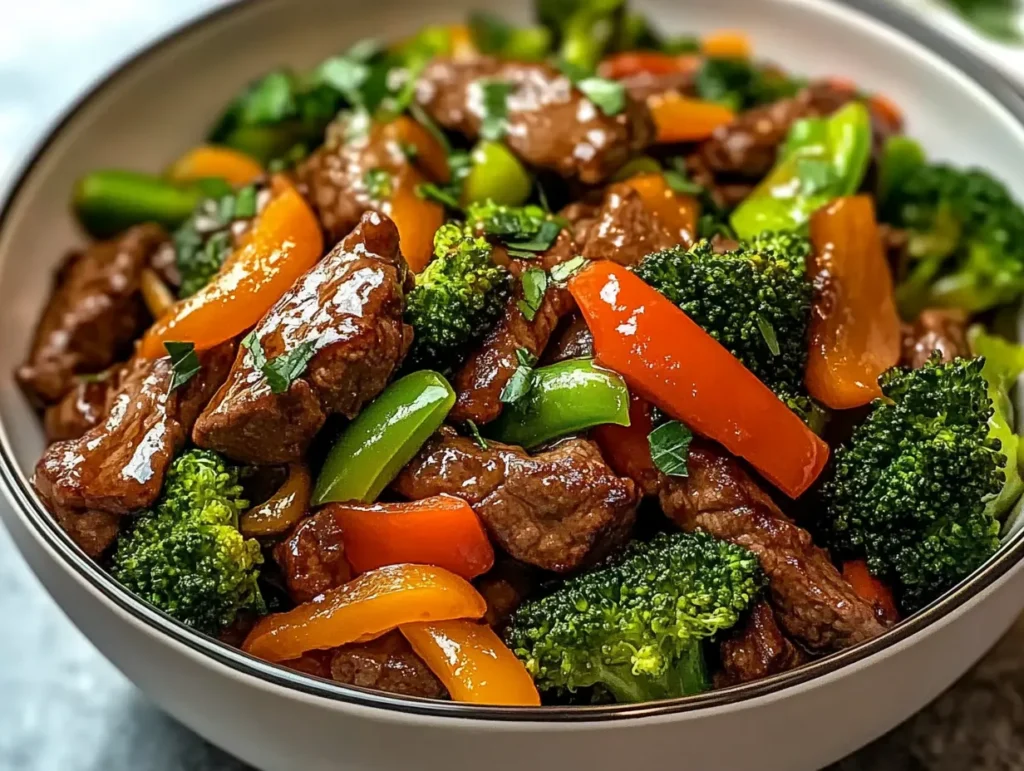
The Secret to Tender Beef in Stir Fry
Before diving into the cooking process, it’s important to understand what makes beef stir fry with vegetables so delicious. The key is properly preparing the beef for quick cooking. The technique of “velveting” is what gives restaurant-quality beef stir fry with vegetables its signature tender texture. This simple process involves coating thinly sliced beef in a mixture of cornstarch, oil, and sometimes baking soda, which creates a protective barrier and helps the meat retain moisture during high-heat cooking. This step is crucial for achieving that melt-in-your-mouth texture that distinguishes excellent beef stir fry with vegetables from ordinary versions.
Additionally, selecting the right cut of beef makes a significant difference. While premium cuts like ribeye or tenderloin can be used, more affordable cuts like flank steak or sirloin work beautifully when sliced properly. The most important factor is cutting the beef against the grain to shorten the muscle fibers, making each bite tender rather than chewy. For more tips on selecting the perfect beef cut, check out this comprehensive guide from The Spruce Eats, which offers excellent advice for home cooks.
How to Make Beef Stir Fry – Step by Step
Step 1: Prepare and Marinate the Beef
- Slice the beef thinly against the grain for maximum tenderness. Aim for slices about ⅛-inch thick.
- In a medium bowl, combine the sliced beef with cornstarch, oil, water, and baking soda (if using).
- Mix well to coat the beef and set aside for at least 15 minutes (or up to 1 hour in the refrigerator) while you prepare the other ingredients.
- This marinating step is crucial as it tenderizes the beef and creates a protective coating that keeps the meat juicy during the high-heat cooking process.
Step 2: Prepare the Sauce and Vegetables
- In a small bowl, whisk together soy sauce, hoisin sauce, sesame oil, honey, minced garlic, grated ginger, water/broth, and cornstarch.
- Mix until well combined and set aside. The cornstarch will help thicken the sauce to create that perfect glossy coating.
- Wash and cut all vegetables into similar-sized pieces to ensure even cooking. Keep the firmer vegetables (like carrots and broccoli) separate from quicker-cooking ones (like bell peppers and snap peas).
- Having all ingredients prepped and within reach (mise en place) is essential for successful stir frying, as the cooking process moves quickly once started.
Step 3: Stir Fry the Beef
- Heat a large wok or skillet over high heat until it’s very hot. You should see wisps of smoke rising from the surface.
- Add 1 tablespoon of high smoke-point oil (such as vegetable or canola oil) and swirl to coat the cooking surface.
- Add the marinated beef in a single layer and let it sear undisturbed for 1-2 minutes to develop a nice caramelized crust.
- Stir and continue cooking for another 1-2 minutes until the beef is nearly cooked through but still slightly pink in the center.
- Remove the beef from the wok and set aside on a clean plate. Don’t worry if it’s not fully cooked – it will finish cooking when returned to the wok later.
Step 4: Stir Fry the Vegetables
- In the same wok, add another tablespoon of oil if needed, maintaining the high heat.
- Add the aromatics (additional minced garlic and ginger if desired) and stir for just 10-15 seconds until fragrant.
- Add the firmer vegetables first (carrots and broccoli) and stir fry for 2-3 minutes, tossing frequently.
- Add the bell peppers, snap peas, and mushrooms, continuing to stir fry for another 2-3 minutes until vegetables are crisp-tender.
- The vegetables should be bright in color and still have some bite – they’ll continue cooking slightly when the sauce is added.
Step 5: Combine and Finish
- Return the beef and any accumulated juices to the wok with the vegetables.
- Give your sauce a quick stir to recombine (the cornstarch tends to settle) and pour it into the wok.
- Stir fry everything together for 1-2 minutes until the sauce thickens and coats everything evenly with a glossy sheen.
- Add the green onions and toss to combine. The residual heat will soften them slightly while maintaining their fresh flavor.
- Taste and adjust seasonings if needed, adding a bit more soy sauce for saltiness or honey for sweetness.
- Remove from heat and serve immediately over your choice of rice or noodles.
- Garnish with sesame seeds and additional green onions for extra flavor and visual appeal.
Pro Tips for Making the Best Beef Stir Fry
Beef Preparation Excellence
- Freeze the beef for 15-30 minutes before slicing to make it easier to cut into thin, even strips.
- Always slice beef against the grain for the most tender result. Look for the lines in the meat and cut perpendicular to them.
- Pat the beef dry with paper towels before marinating to remove excess moisture, which helps achieve better browning.
- Don’t skimp on marinating time – even 15 minutes makes a significant difference in the tenderness of the final dish.
- Use a sharp knife to get clean, precise cuts – a dull knife can tear the meat fibers instead of slicing cleanly through them.
Cooking Technique Mastery
- Don’t overcrowd the pan – if necessary, cook in batches to ensure proper searing. Overcrowding causes steaming instead of searing.
- Have all ingredients prepped and ready before you start cooking – stir frying moves quickly! This is called “mise en place” in professional kitchens.
- Use a high smoke-point oil like vegetable, canola, or peanut oil to prevent burning and off flavors.
- Cook over high heat to achieve the perfect sear on the beef and vegetables. The wok or pan should be hot enough that ingredients sizzle immediately upon contact.
- Keep ingredients moving in the pan with a constant stirring motion to ensure even cooking and prevent burning.
- Add the vegetables in order of cooking time – hardier vegetables first, delicate ones last to ensure everything is perfectly cooked.
- Don’t overcook the vegetables – they should remain crisp-tender for the best texture and retain their vibrant colors and nutrients.
Sauce and Flavor Enhancements
- Balance the flavors in your sauce – aim for a harmonious blend of sweet, salty, umami, and acidic notes.
- Customize the sauce – add red pepper flakes for heat, rice vinegar for tang, or more honey for sweetness.
- Consider adding a splash of Shaoxing wine or dry sherry to the sauce for an authentic Chinese flavor profile.
- Fresh aromatics make a difference – use freshly minced garlic and grated ginger rather than pre-prepared versions for the most vibrant flavor.
- Toast sesame seeds in a dry pan before using them as garnish to enhance their nutty flavor.
- Add a teaspoon of oyster sauce to the stir fry sauce for deeper umami richness that complements the beef perfectly.
Best Ways to Serve Beef Stir Fry
The versatility of beef stir fry with vegetables extends to how you can serve it. Here are some delicious serving options to complete your meal:
Classic Rice Pairings
- Over steamed white rice for a classic pairing that soaks up the delicious sauce
- With brown rice for a more nutritious option with added fiber and a nutty flavor
- Try jasmine rice for a fragrant, slightly sticky base that complements Asian flavors beautifully
- Coconut rice adds a subtle sweetness that works wonderfully with the savory beef
Noodle Alternatives
- Alongside lo mein noodles for an authentic Chinese restaurant experience
- Over rice noodles for a lighter option with a delicate texture
- With udon noodles for a heartier, chewier texture that stands up well to the robust sauce
- Soba noodles add a nutty flavor and boost the nutritional profile with buckwheat goodness
- Ramen noodles (discard the seasoning packet) make an economical and quick base
Low-Carb Options
- Over cauliflower rice for a low-carb alternative that mimics the texture of rice
- Zucchini noodles (zoodles) create a fresh, light base that adds extra vegetables
- Wrapped in lettuce cups for a light, handheld meal with extra crunch
- Served on a bed of steamed cabbage for a tender yet low-carb foundation
- Shirataki noodles offer an almost zero-carb option with a unique texture
Presentation and Accompaniments
- Garnished with sesame seeds and extra green onions for visual appeal and flavor
- With a side of homemade egg rolls or spring rolls for a complete takeout-style meal
- Add a cucumber salad with rice vinegar dressing for a refreshing contrast
- Serve with pickled vegetables on the side for a tangy counterpoint
- Include chili oil or sambal oelek on the table for those who enjoy extra heat
- Fresh lime wedges on the side allow diners to add a bright, citrusy finish
Remember that the sauce in this beef stir fry is designed to complement rather than overwhelm your base of choice, so feel free to experiment with different serving options to find your family’s favorite combination!
Nutritional Information for Beef Stir Fry
This beef stir fry with vegetables isn’t just delicious – it’s also packed with nutrients that make it a well-balanced meal option. Here’s a breakdown of what you’re getting in each serving:
- Calories: 350 kcal per serving
- Protein: 28g – excellent for muscle repair and growth
- Carbohydrates: 24g – provides energy without overloading on carbs
- Fat: 15g – mostly from healthy oils used in cooking
- Fiber: 4g – promotes digestive health and helps you feel full longer
- Sugar: 14g – mostly from natural sources in vegetables and the small amount in the sauce
- Vitamin A: 6700 IU – supports vision and immune function
- Vitamin C: 95mg – boosts immunity and collagen production
- Calcium: 95mg – essential for bone health
- Iron: 3mg – critical for oxygen transport in the blood
- Potassium: 900mg – helps maintain healthy blood pressure
Note: Nutritional values are approximate and do not include rice or noodles. Values may vary based on specific ingredients and portions used.
Health Benefits of Beef Stir Fry
This 30-minute beef stir fry with vegetables isn’t just a convenient meal option – it’s also packed with health benefits that make it a smart addition to your regular meal rotation:
- High-Quality Protein Source: The beef provides complete protein with all essential amino acids needed for muscle maintenance and growth. According to the American Heart Association, lean beef can be part of a heart-healthy diet when consumed in moderation.
- Nutrient-Dense Vegetables: The colorful mix of vegetables delivers a wide spectrum of vitamins, minerals, and antioxidants that support overall health and immune function. For more information on the benefits of eating colorful vegetables, visit Harvard Health’s Nutrition Source.
- Balanced Macronutrients: With a good balance of protein, carbs, and fats, this beef stir fry with vegetables helps maintain steady energy levels and satisfaction.
- Customizable for Dietary Needs: Easily adapt this recipe for various dietary requirements – lower the sodium, reduce the sugar, or increase the vegetables as needed.
- Portion-Controlled Meal: When prepared as directed, this stir fry provides a satisfying meal with controlled portions that help support weight management goals.
Storage & Leftovers
Making this beef stir fry with vegetables in larger batches can be a smart meal prep strategy. Here’s how to store and enjoy the leftovers:
Short-Term Storage
- Refrigeration: Store leftover beef stir fry in an airtight container for up to 3-4 days.
- Separation: For best texture, store the stir fry separate from rice or noodles if possible.
- Quick cooling: Allow the stir fry to cool to room temperature before refrigerating, but don’t leave it out for more than 2 hours.
- Container selection: Glass containers with secure lids work best for maintaining freshness and preventing sauce leaks.
Freezing Guidelines
- Freezing duration: You can freeze beef stir fry for up to 2-3 months for optimal quality.
- Texture changes: Be aware that the vegetables may lose some crispness upon thawing, but the flavor will remain delicious.
- Portioning: Freeze in individual portions for quick single-serving meals.
- Proper containers: Use freezer-safe containers or heavy-duty freezer bags with excess air removed.
- Labeling: Always label with the date and contents to keep track of your frozen meals.
Reheating Methods
- Stovetop (preferred): Warm leftovers in a skillet over medium heat until hot (internal temperature of 165°F or 74°C), adding a splash of water or broth if needed to loosen the sauce and prevent sticking.
- Microwave: For quick reheating, microwave in 30-second increments, stirring between each interval until heated through. Cover loosely to prevent splattering.
- Oven method: Place in an oven-safe dish, cover with foil, and heat at 350°F (175°C) for about 10-15 minutes until thoroughly heated.
- Adding freshness: Sprinkle with fresh green onions after reheating to add a pop of color and fresh flavor.
Meal Prep Strategies
- Component prep: Prepare the vegetables and sauce up to 2 days ahead and store separately in the refrigerator.
- Marinate ahead: The beef can be sliced and marinated up to 24 hours in advance for even more flavor development.
- Rice preparation: Cook rice or noodles ahead of time and refrigerate separately for quick meal assembly.
- Weekly planning: This beef stir fry recipe doubles easily for intentional leftovers throughout the week.
- Repurposing ideas: Transform leftovers into new meals by using them as filling for wraps, mixing with beaten eggs for a stir fry frittata, or adding to fried rice.
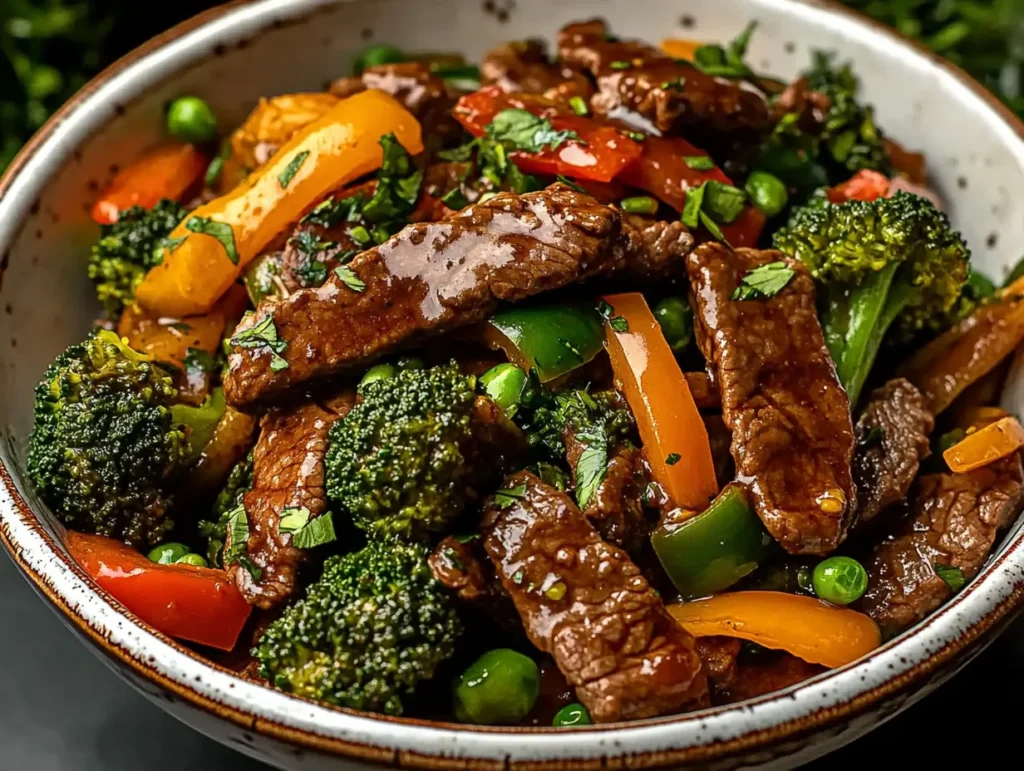
FAQs for Beef Stir Fry
What is the best cut of beef for stir fry?
Flank steak, sirloin, and skirt steak are excellent choices for beef stir fry. These cuts have good flavor and become tender when sliced thinly against the grain and cooked quickly at high heat. Ribeye and strip steak also work well if you want a more premium option, while chuck steak can be a budget-friendly alternative if sliced very thinly and marinated properly.
Can I make beef stir fry ahead of time?
Yes! You can prepare all the components ahead of time: slice the beef, chop the vegetables, and mix the sauce up to 24 hours in advance. Store everything separately in the refrigerator, then combine and cook when ready to serve. This prep-ahead approach makes weeknight cooking much faster, turning this 30-minute meal into a 10-minute cooking session.
What vegetables work best in beef stir fry?
The best vegetables for stir fry are those that cook quickly and maintain some crispness. Bell peppers, broccoli, carrots, snap peas, snow peas, mushrooms, bok choy, and zucchini are all excellent choices. Feel free to mix and match based on what you have available or is in season. Aim for a variety of colors and textures to create a visually appealing and nutritionally diverse meal.
Can I substitute the beef with another protein?
Absolutely! This stir fry recipe works well with chicken, pork, shrimp, or tofu as alternatives to beef. Adjust cooking times accordingly, as these proteins may cook more quickly than beef. Chicken breast or thighs should be cooked to 165°F (74°C), pork to 145°F (63°C), and shrimp just until pink and opaque. Tofu shoul
Creative Variations of Beef Stir Fry
The classic beef stir fry with vegetables recipe is just the beginning. Here are some creative variations to keep this 30-minute meal exciting in your dinner rotation:
Asian-Inspired Regional Variations
- Szechuan Beef Stir Fry: Add dried red chilies, Szechuan peppercorns, and doubanjiang (spicy bean paste) for an authentic numbing-spicy flavor profile that’s characteristic of this Chinese province.
- Korean Beef Stir Fry: Incorporate gochujang (Korean chili paste), a touch of brown sugar, and served with kimchi on the side for a Korean-inspired twist.
- Thai Beef Stir Fry: Add fish sauce, Thai basil, and lime juice to create a Southeast Asian flavor profile with bright, aromatic notes.
- Japanese Beef Stir Fry: Use thinly sliced beef, a sauce with mirin, sake, and a touch of sugar for a teriyaki-like flavor, served with Japanese-style vegetables like shiitake mushrooms and shredded cabbage.
Dietary Adaptations
- Low-Carb Beef Stir Fry: Serve over cauliflower rice and increase the ratio of lower-carb vegetables like bell peppers, broccoli, and mushrooms.
- Paleo Beef Stir Fry: Use coconut aminos instead of soy sauce, honey instead of sugar, and arrowroot powder instead of cornstarch for a paleo-compliant version.
- Extra Protein Beef Stir Fry: Add scrambled eggs or tofu along with the beef for an extra protein boost.
- Vegetable-Forward Beef Stir Fry: Double or triple the vegetables and use half the amount of beef for a more economical and fiber-rich meal.
Related Recipes
- Chicken Stir Fry with Honey Garlic Sauce – A sweet and savory alternative using chicken breast that’s perfect for those who prefer white meat
- Shrimp and Vegetable Stir Fry – A seafood option ready in just 15 minutes, ideal for quick weeknight dinners
- Vegetable Lo Mein – A perfect side dish to complement your beef stir fry, or a standalone vegetarian option
- Homemade Egg Rolls – A delicious appetizer to create a complete Asian-inspired meal that will impress guests
- Sesame Ginger Salmon – Another quick and healthy Asian-inspired dinner option for seafood lovers
- Easy Fried Rice – A classic accompaniment that can incorporate leftover vegetables and proteins
- Asian Cucumber Salad – A light, refreshing side that balances the savory richness of beef stir fry
Tools and Equipment for Perfect Stir Fry
While you can certainly make beef stir fry with basic kitchen equipment, having the right tools can elevate your stir-frying experience:
- Wok: The traditional choice for stir-frying, its high sides and rounded bottom create an ideal cooking environment with different heat zones.
- Carbon Steel Skillet: A great alternative to a wok, providing excellent heat retention and distribution.
- Wooden or Metal Stir Fry Spatula: The long handle and shovel-like shape make it easier to toss ingredients quickly.
- Sharp Chef’s Knife: Essential for slicing beef thinly and cutting vegetables uniformly.
- Heat-Resistant Cutting Board: Provides a stable surface for ingredient preparation.
- Small Bowls for Mise en Place: Keeps ingredients organized and ready to add at the right moment.
- Microplane Grater: Perfect for finely grating fresh ginger and garlic to release maximum flavor.
Conclusion and Final Thoughts
Now you know how to make the best beef stir fry with vegetables at home in just 30 minutes! This versatile, nutrient-packed meal is perfect for busy weeknights and will quickly become a family favorite. With its perfect balance of tender beef, crisp vegetables, and savory sauce, this beef stir fry with vegetables delivers restaurant-quality flavor with minimal effort.
The beauty of beef stir fry with vegetables lies in its adaptability. Don’t be afraid to experiment with different vegetables based on seasonal availability, or adjust the sauce ingredients to suit your family’s taste preferences. The techniques you’ve learned here – properly slicing and marinating beef, cooking in the right sequence, and balancing flavors in the sauce – can be applied to countless variations of beef stir fry with vegetables recipes.
Remember that the key to stir-fry success is preparation. Having all ingredients ready before you begin cooking ensures a smooth process and prevents anything from overcooking while you’re chopping the next ingredient. With practice, this 30-minute beef stir fry with vegetables will become second nature, opening the door to a world of quick, healthy, and delicious meals.
For more Asian-inspired recipes, be sure to check out our collection of Quick Asian Dinner Ideas or learn about Essential Asian Cooking Techniques on our website. You might also enjoy reading about the History of Stir-Frying from Serious Eats for a deeper understanding of this cooking method.
Don’t forget to share your creations and let us know your favorite variations in the comments below! Did you try a different combination of vegetables? Did you spice it up with chili flakes or add a unique twist to the sauce? We’d love to hear about your beef stir fry with vegetables adventures!
Would you like to see more quick and easy dinner recipes? Share this beef stir fry recipe with friends and family who need delicious 30-minute meal ideas!
Recipe adapted from betterhomebase.com and enhanced with additional tips and techniques.
Print
Best Beef Stir Fry with Vegetables (30-Minutes)
- Total Time: 30 minutes
- Yield: 4 servings 1x
- Diet: Gluten Free
Description
This 30-minute beef stir fry with vegetables combines tender beef strips with colorful vegetables in a savory sauce. Perfect for busy weeknights, this easy recipe delivers restaurant-quality flavor with minimal effort and is completely customizable.
Ingredients
- 1 pound beef sirloin or flank steak, thinly sliced against the grain
- 1 tablespoon cornstarch
- 1 tablespoon vegetable oil
- 1 tablespoon water
- ¼ teaspoon baking soda (optional, for extra tenderness)
- 1 bell pepper (red or multi-colored), sliced
- 1 cup broccoli florets
- 1 carrot, julienned
- 1 cup snap peas or snow peas
- 8 oz mushrooms, sliced (optional)
- 2–3 green onions, chopped
- ¼ cup low-sodium soy sauce
- 2 tablespoons hoisin sauce
- 1 tablespoon sesame oil
- 1 tablespoon honey or brown sugar
- 2 cloves garlic, minced
- 1 tablespoon fresh ginger, grated
- ¼ cup water or beef broth
- 1 tablespoon cornstarch (to thicken)
- Sesame seeds for garnish
- Additional chopped green onions for garnish
Instructions
- Slice the beef thinly against the grain for maximum tenderness. Aim for slices about ⅛-inch thick.
- In a medium bowl, combine the sliced beef with cornstarch, oil, water, and baking soda (if using). Mix well to coat the beef and set aside for at least 15 minutes.
- In a small bowl, whisk together soy sauce, hoisin sauce, sesame oil, honey, minced garlic, grated ginger, water/broth, and cornstarch. Mix until well combined and set aside.
- Wash and cut all vegetables into similar-sized pieces to ensure even cooking.
- Heat a large wok or skillet over high heat until it’s very hot. Add 1 tablespoon of high smoke-point oil and swirl to coat.
- Add the marinated beef in a single layer and let it sear undisturbed for 1-2 minutes to develop a nice caramelized crust.
- Stir and continue cooking for another 1-2 minutes until the beef is nearly cooked through but still slightly pink in the center.
- Remove the beef from the wok and set aside on a clean plate.
- In the same wok, add another tablespoon of oil if needed, maintaining the high heat.
- Add the firmer vegetables first (carrots and broccoli) and stir fry for 2-3 minutes, tossing frequently.
- Add the bell peppers, snap peas, and mushrooms, continuing to stir fry for another 2-3 minutes until vegetables are crisp-tender.
- Return the beef and any accumulated juices to the wok with the vegetables.
- Give your sauce a quick stir to recombine and pour it into the wok.
- Stir fry everything together for 1-2 minutes until the sauce thickens and coats everything evenly with a glossy sheen.
- Add the green onions and toss to combine.
- Remove from heat and serve immediately over rice or noodles.
- Garnish with sesame seeds and additional green onions if desired.
Notes
- Freeze the beef for 15-30 minutes before slicing to make it easier to cut into thin, even strips.
- Always slice beef against the grain for the most tender result.
- Don’t overcrowd the pan – if necessary, cook in batches to ensure proper searing.
- Have all ingredients prepped and ready before you start cooking (mise en place).
- Use a high smoke-point oil like vegetable, canola, or peanut oil.
- Cook over high heat to achieve the perfect sear on the beef and vegetables.
- Add vegetables in order of cooking time – hardier vegetables first, delicate ones last.
- Don’t overcook the vegetables – they should remain crisp-tender for the best texture.
- Customize the sauce – add red pepper flakes for heat or more honey for sweetness.
- For meal prep, prepare the vegetables and sauce up to 2 days ahead and store separately in the refrigerator.
- Prep Time: 15 minutes
- Cook Time: 15 minutes
- Category: Main Dish
- Method: Stir Fry
- Cuisine: Asian
Nutrition
- Serving Size: 1/4 of recipe
- Calories: 350 kcal
- Sugar: 14g
- Sodium: 900mg
- Fat: 15g
- Saturated Fat: 3g
- Unsaturated Fat: 10g
- Trans Fat: 0g
- Carbohydrates: 24g
- Fiber: 4g
- Protein: 28g
- Cholesterol: 70mg
Keywords: beef stir fry with vegetables, quick dinner, 30 minute meal, easy beef recipe, Asian beef stir fry, weeknight dinner, healthy beef recipe
